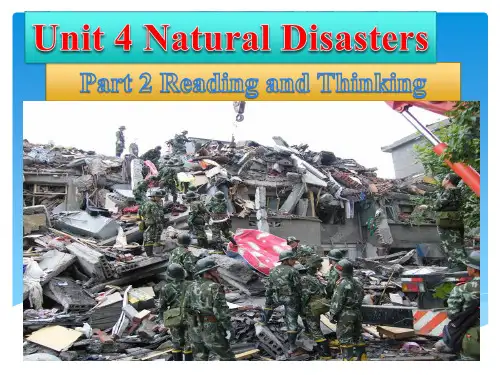东营市一中高一下学期人教版(2019)book 2 unit 4 reading and thinking(共18张PPT)
- 格式:pptx
- 大小:3.63 MB
- 文档页数:18
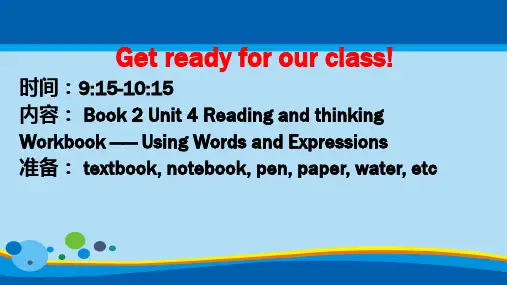
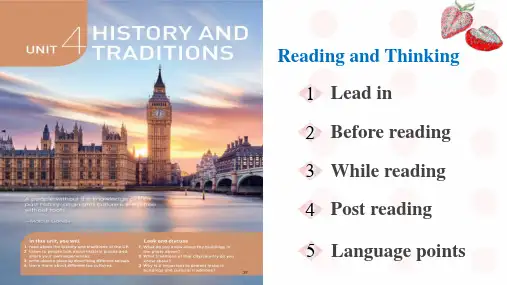
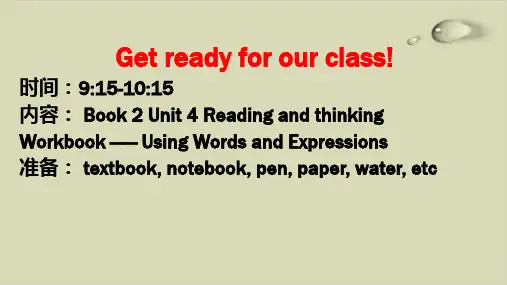
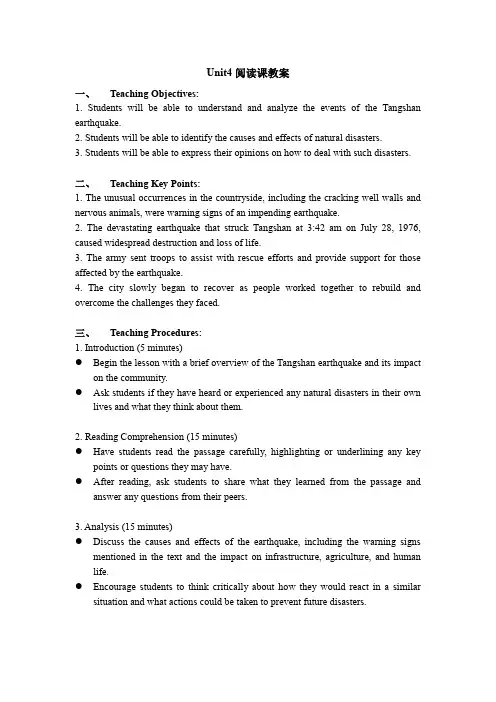
Unit4阅读课教案一、Teaching Objectives:1. Students will be able to understand and analyze the events of the Tangshan earthquake.2. Students will be able to identify the causes and effects of natural disasters.3. Students will be able to express their opinions on how to deal with such disasters.二、Teaching Key Points:1. The unusual occurrences in the countryside, including the cracking well walls and nervous animals, were warning signs of an impending earthquake.2. The devastating earthquake that struck Tangshan at 3:42 am on July 28, 1976, caused widespread destruction and loss of life.3. The army sent troops to assist with rescue efforts and provide support for those affected by the earthquake.4. The city slowly began to recover as people worked together to rebuild and overcome the challenges they faced.三、Teaching Procedures:1. Introduction (5 minutes)●Begin the lesson with a brief overview of the Tangshan earthquake and its impacton the community.●Ask students if they have heard or experienced any natural disasters in their ownlives and what they think about them.2. Reading Comprehension (15 minutes)●Have students read the passage carefully, highlighting or underlining any keypoints or questions they may have.●After reading, ask students to share what they learned from the passage andanswer any questions from their peers.3. Analysis (15 minutes)●Discuss the causes and effects of the earthquake, including the warning signsmentioned in the text and the impact on infrastructure, agriculture, and human life.●Encourage students to think critically about how they would react in a similarsituation and what actions could be taken to prevent future disasters.4. Writing Activity (10 minutes)●Ask students to write a short essay on one of the following topics:⏹How can we better prepare for natural disasters?⏹What can we do to help those affected by a disaster?●Encourage students to use evidence from the text to support their arguments andto vary their sentence structures and vocabulary.5. Conclusion (5 minutes)●Review the main points of the lesson and emphasize the importance ofunderstanding and responding to natural disasters.●Ask students to reflect on what they learned today and how they can apply it intheir own lives.Homework:1. Have students research a natural disaster that occurred in their own country or region and write a report summarizing the causes, effects, and response strategies used by local authorities.2. Ask students to discuss with their families or classmates how they would handle a similar situation in case of a natural disaster and why it is important to have such plans in place.。
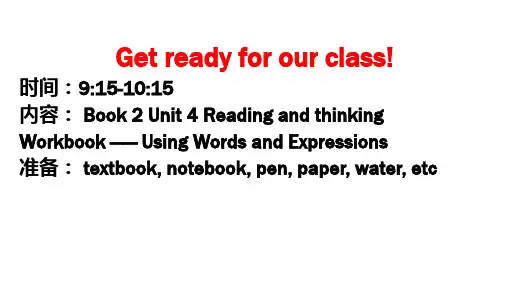
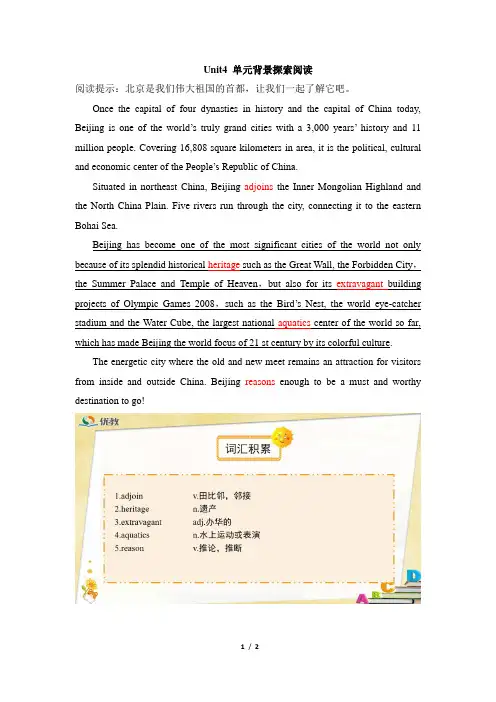
Unit4 单元背景探索阅读阅读提示:北京是我们伟大祖国的首都,让我们一起了解它吧。
Once the capital of four dynasties in history and the capital of China today, Beijing is one of the world’s truly grand cities with a 3,000 years’history and 11 million people. Covering 16,808 square kilometers in area, it is the political, cultural and ec onomic center of the People’s Republic of China.Situated in northeast China, Beijing adjoins the Inner Mongolian Highland and the North China Plain. Five rivers run through the city, connecting it to the eastern Bohai Sea.Beijing has become one of the most significant cities of the world not only because of its splendid historical heritage such as the Great Wall, the Forbidden City,the Summer Palace and Temple of Heaven,but also for its extravagant building projects of Olympic Games 2008,such as the Bird’s Nest, the world eye-catcher stadium and the Water Cube, the largest national aquatics center of the world so far, which has made Beijing the world focus of 21 st century by its colorful culture.The energetic city where the old and new meet remains an attraction for visitors from inside and outside China. Beijing reasons enough to be a must and worthy destination to go!。
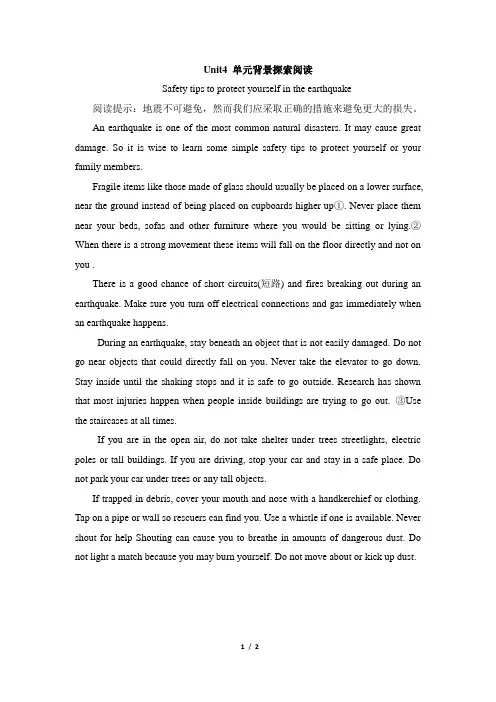
Unit4 单元背景探索阅读Safety tips to protect yourself in the earthquake阅读提示:地震不可避免,然而我们应采取正确的措施来避免更大的损失。
An earthquake is one of the most common natural disasters. It may cause great damage. So it is wise to learn some simple safety tips to protect yourself or your family members.Fragile items like those made of glass should usually be placed on a lower surface, near the ground instead of being placed on cupboards higher up①. Never place them near your beds, sofas and other furniture where you would be sitting or lying.②When there is a strong movement these items will fall on the floor directly and not on you .There is a good chance of short circuits(短路) and fires breaking out during an earthquake. Make sure you turn off electrical connections and gas immediately when an earthquake happens.During an earthquake, stay beneath an object that is not easily damaged. Do not go near objects that could directly fall on you. Never take the elevator to go down. Stay inside until the shaking stops and it is safe to go outside. Research has shown that most injuries happen when people inside buildings are trying to go out. ③Use the staircases at all times.If you are in the open air, do not take shelter under trees streetlights, electric poles or tall buildings. If you are driving, stop your car and stay in a safe place. Do not park your car under trees or any tall objects.If trapped in debris, cover your mouth and nose with a handkerchief or clothing. Tap on a pipe or wall so rescuers can find you. Use a whistle if one is available. Never shout for help Shouting can cause you to breathe in amounts of dangerous dust. Do not light a match because you may burn yourself. Do not move about or kick up dust.。
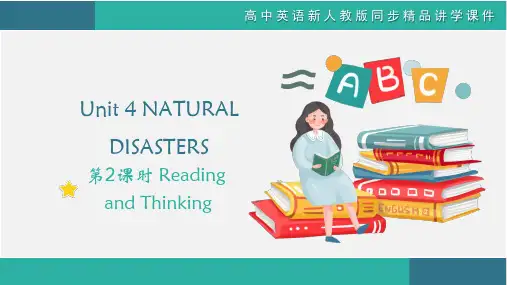
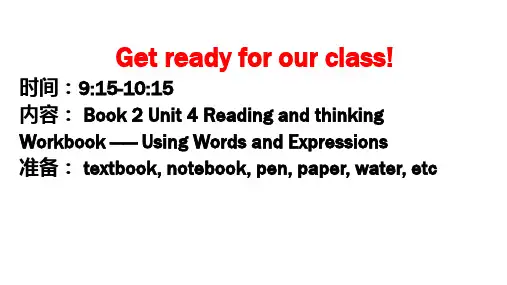
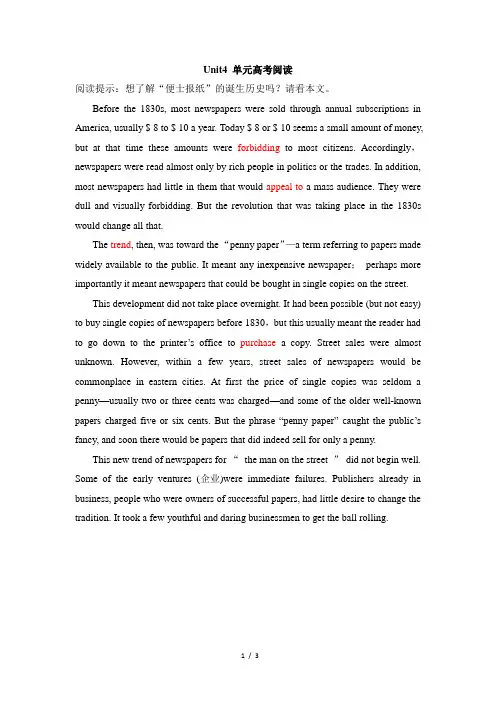
Unit4 单元高考阅读阅读提示:想了解“便士报纸”的诞生历史吗?请看本文。
Before the 1830s, most newspapers were sold through annual subscriptions in America, usually $ 8 to $ 10 a year. Today $ 8 or $ 10 seems a small amount of money, but at that time these amounts were forbidding to most citizens. Accordingly,newspapers were read almost only by rich people in politics or the trades. In addition, most newspapers had little in them that would appeal to a mass audience. They were dull and visually forbidding. But the revolution that was taking place in the 1830s would change all that.The trend, then, was toward the “penny paper”—a term referring to papers made widely available to the public. It meant any inexpensive newspaper;perhaps more importantly it meant newspapers that could be bought in single copies on the street.This development did not take place overnight. It had been possible (but not easy) to buy single copies of newspapers before 1830,but this usually meant the reader had to go down to the printer’s office to purchase a copy. Street sales were almost unknown. However, within a few years, street sales of newspapers would be commonplace in eastern cities. At first the price of single copies was seldom a penny—usually two or three cents was charged—and some of the older well-known papers charged five or six cents. But the phrase “penny paper” caught the public’s fancy, and soon there would be papers that did indeed sell for only a penny.This new trend of newspapers for “the man on the street ”did not begin well. Some of the early ventures (企业)were immediate failures. Publishers already in business, people who were owners of successful papers, had little desire to change the tradition. It took a few youthful and daring businessmen to get the ball rolling.。
